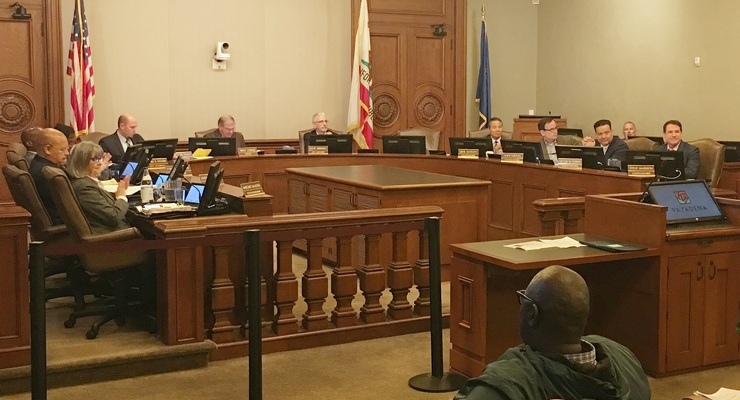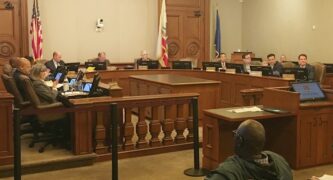
The City of Pasadena should sue the State over its attempts to “destroy single-family neighborhoods” in Pasadena, Councilmember and mayoral candidate Victor Gordo said during the Council’s meeting Monday night.
Gordo’s remarks came as the City Council grapples with the onset of a tsunami of state housing legislation which affects all California cities set to take effect on January 1, 2020.
Pasadena Planning Director David Reyes led City staff in delivering a legislative update to the Council which spelled out the larger picture of the State and City’s housing landscapes.
The new State laws aim to dramatically increase the amount of available housing in California, but supersede local zoning laws in the process.
Nine major bills will take effect next month, affecting regulations on everything from Accessory Dwelling Units (ADUs), setbacks, parking, and future developments.
“We need to defend ourselves aggressively,” said Gordo, who even suggested altering local bus routes so that new housing ordinances wouldn’t affect neighborhoods where new developments would be built near existing bus lines.
“We cannot allow the State to control us,” said Gordo. “They are stealing our quality of life.”
Mayor Terry Tornek agreed with Gordo, saying, “The State has concluded that single-family housing is not the future of Pasadena.”
Resident Erika Foy, an advocate for single-family neighborhoods, told the Council, “Tell the State to get off our backs. We’ve issued far more affordable housing permits than all of the cities in the San Gabriel Valley combined.”
West Pasadena resident Nina Chomsky also told the Council, “This is appalling. We are a leader in housing, and local control is the answer.” Chomsky added that Pasadena should form partnerships with other local cities to litigate against the state.
“With the right thinking,” she said, “we can win.”
Councilmember Margaret McAustin agreed that the City should hold firm, but argued a more moderate approach.
“It’s extra-important that we hold the line,” Said McAustin, “but we want to work with the state as well.”
Housing advocates, however, argued just as fervently that the City should instead work closely with the state.
“I can’t believe what I am hearing,” said Pasadena resident Sonja Berndt.
“Litigation is a really bad idea.”
Housing activist Ed Washatka told the Council, “Affordable housing should be the goal, that’s the tip of the arrow. Look for ways to say ‘yes.’”
Planning Director David Reyes said the state legislature had already passed numerous bills over the past two years addressing the State’s housing and homelessness crisis.
But the 2019 legislative session resulted in the passage of a new package of far-reaching legislation, including Senate Bill 330, Assembly Bill 1763, and a package of bills relating to Accessory Dwelling Units (ADUs).
- SB 330 prohibits the reduction of housing development capacity through downzoning and prohibits housing moratoriums for a period of five years, while also creating a new preliminary application process and requiring that new housing development meet certain requirements when replacing existing housing units.
- AB 1763 creates a more robust density bonus incentive program for projects that consist of 100% affordable housing.
The various ADU bills will limit local cities’ abilities to impose certain development standards and impact fees, would allow ADUs in multi-family zones, and require that a Junior ADU be allowed within an existing residence, in addition to a newly constructed ADU.
In addition, the State has long adopted the Regional Housing Needs Assessment (RHNA) as part of its process of updating local housing elements of the General Plan. The RHNA specifies the new housing numbers required within each jurisdiction during specified planning periods. In the coming years, the housing numbers will increase astronomically, as Reyes reported.
Pasadena — whose previous required target was 1,332 housing units—a goal the City has not yet achieved—will see a requirement of 9,469 units in the coming years, an increase of 611%.
“RHNA is a flawed policy,” said Councilmember Steve Madison. “Cities can’t choose their own destinies.”
As Reyes noted, despite the push to increase housing in California, Pasadena has “long been recognized as a leader in the areas of urban planning and affordable housing.”
‘The State is trying to catch up with what Pasadena is doing,” he told the Council.
The City’s 2015 General Plan vision encourages growth primarily in areas within walking distance of the City’s six Metro Gold Line light rail stations, as well as within the downtown areas and commercial corridors, said the report, and 87% of projects approved since 2014 are located within a half mile of a transit station.
Pasadena also added 1.07 jobs added per housing unit built between 2005-2015, compared to 1.77 jobs added per housing unit built across the five-county region, which the report called “an important component of a Greenhouse Gas emission reduction plan.”
The City also issued permits for more than three times the number of units allocated for market -rate housing in its current Housing Element Cycle (2014-2021), and issued permits for over 230 new affordable units since 2014 at various affordability levels, said the report.
Earlier this year, Pasadena also adopted an ordinance to increase the inclusionary housing requirement from 15% to 20%, remove trade-down provisions, and increase inclusionary housing in-lieu fees, which can be leveraged by the City to preserve, rehabilitate, or build new affordable units. It also adopted an ordinance to allow the conversion of existing hotels and motels to affordable housing, including permanent supportive housing.
Reyes also noted that, while Pasadena has its own local inclusionary housing ordinance, “existing State law related to density bonus does not take this into account.”
SB 50, which would increase density around transit does not consider that Pasadena allows up to 87 units per acre—which the report called “incredibly dense” —in many of the City’s Transit-oriented District areas.
Following the report, Mayor Tornek said he was pleased with the wide range of opinions on the subject, even though he knew they were “diametrically opposed to each other.”
“I think it’s terrific,” he said. “The discussion will continue.”














 0 comments
0 comments


